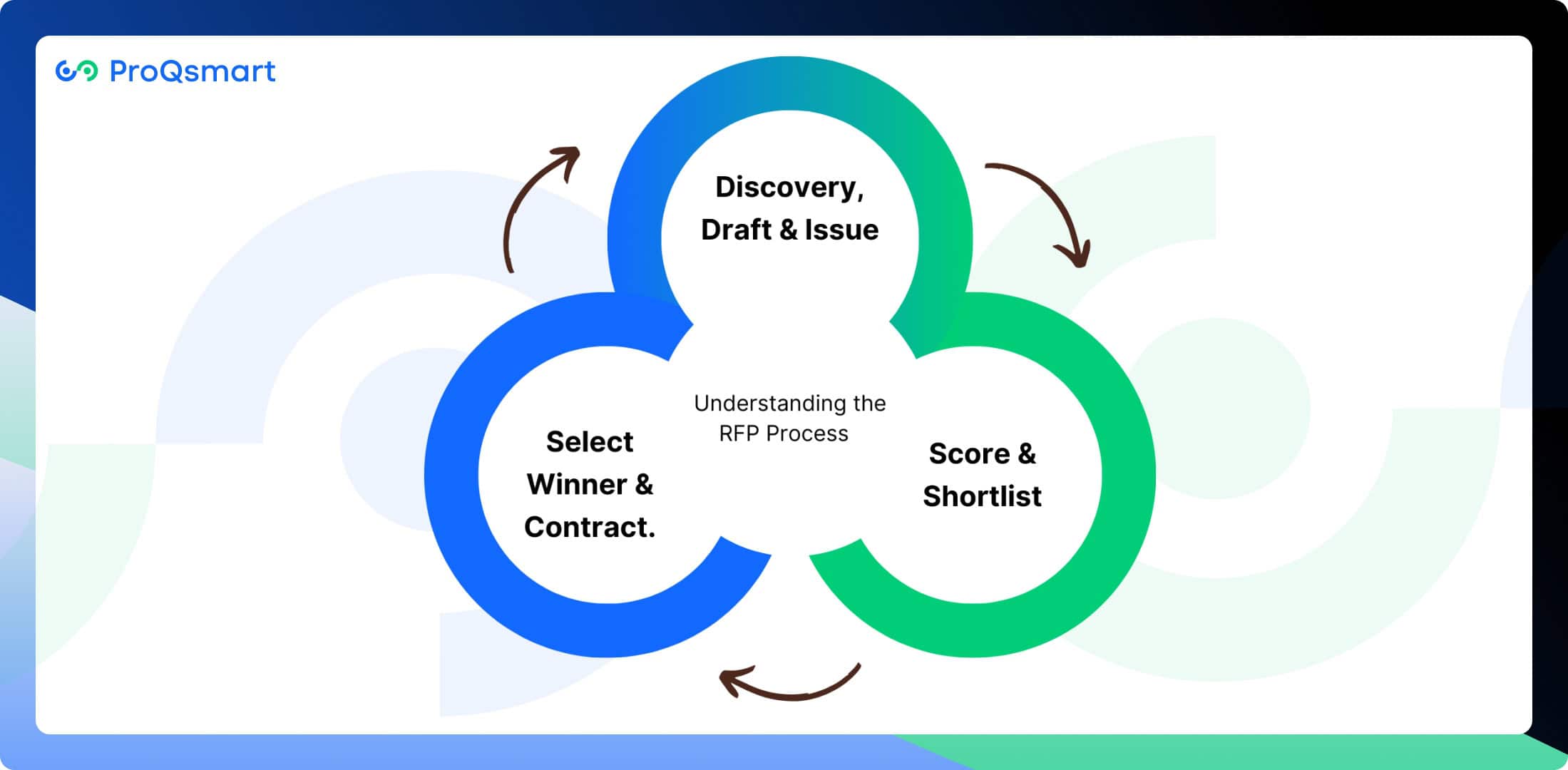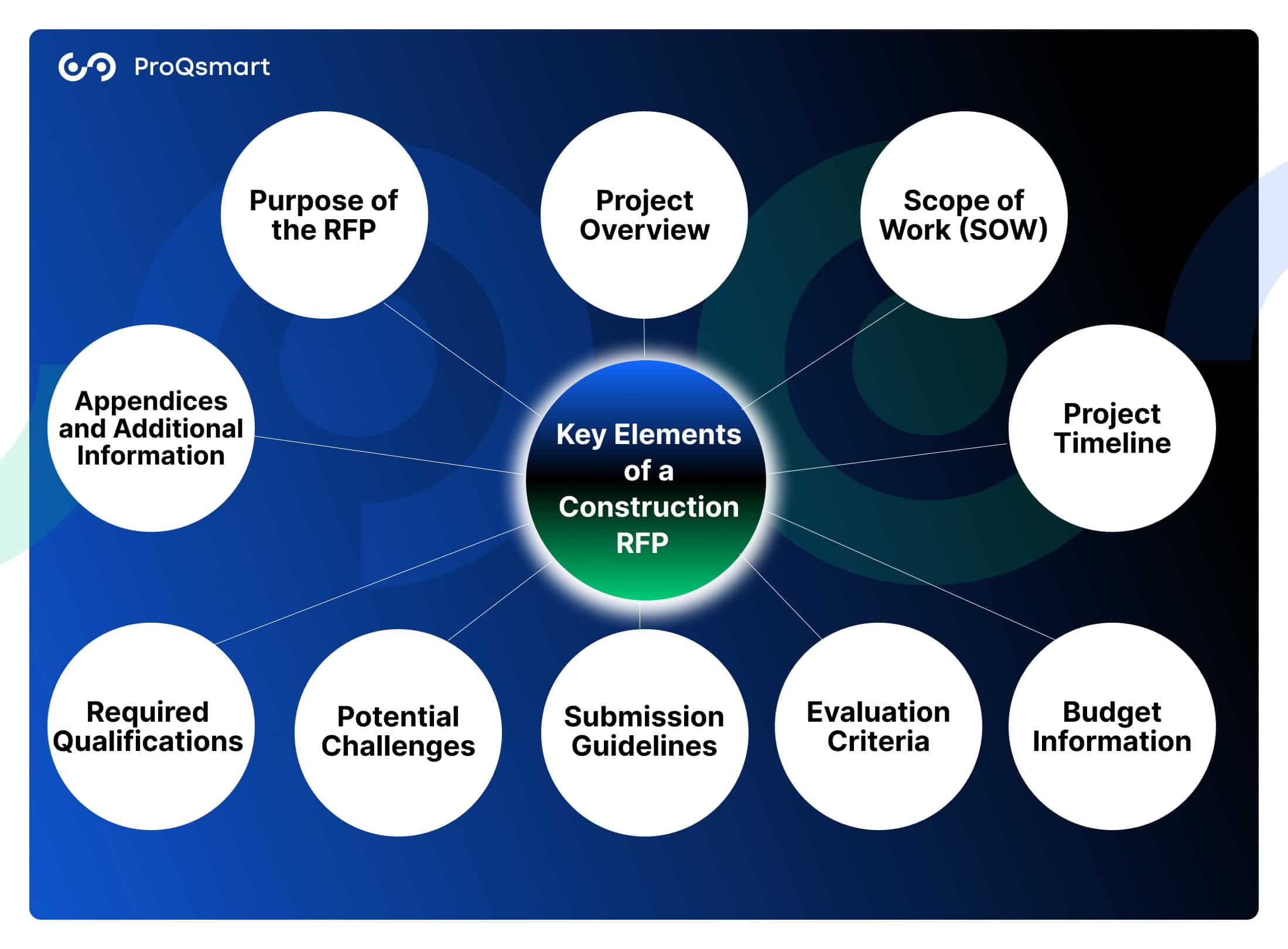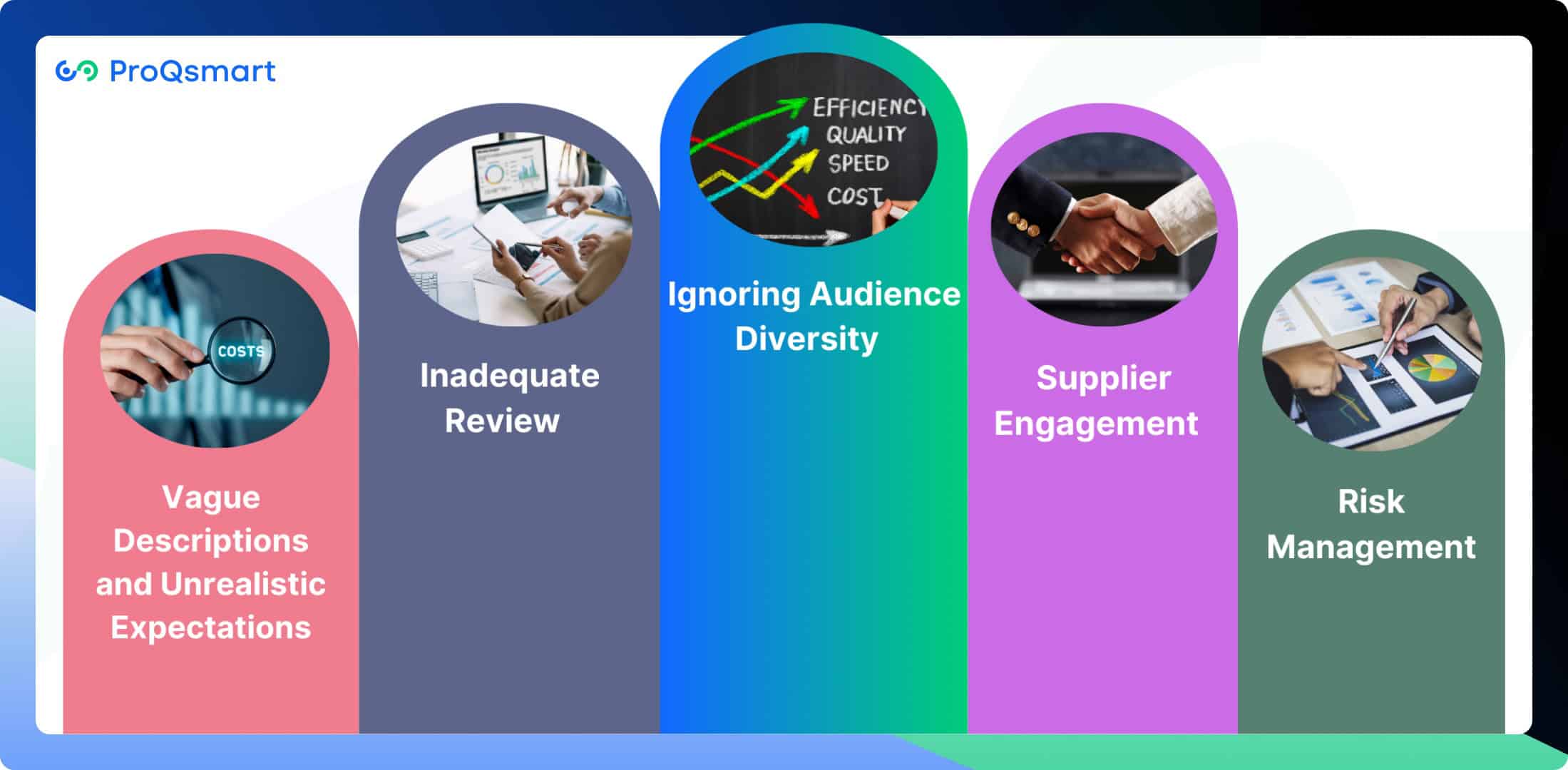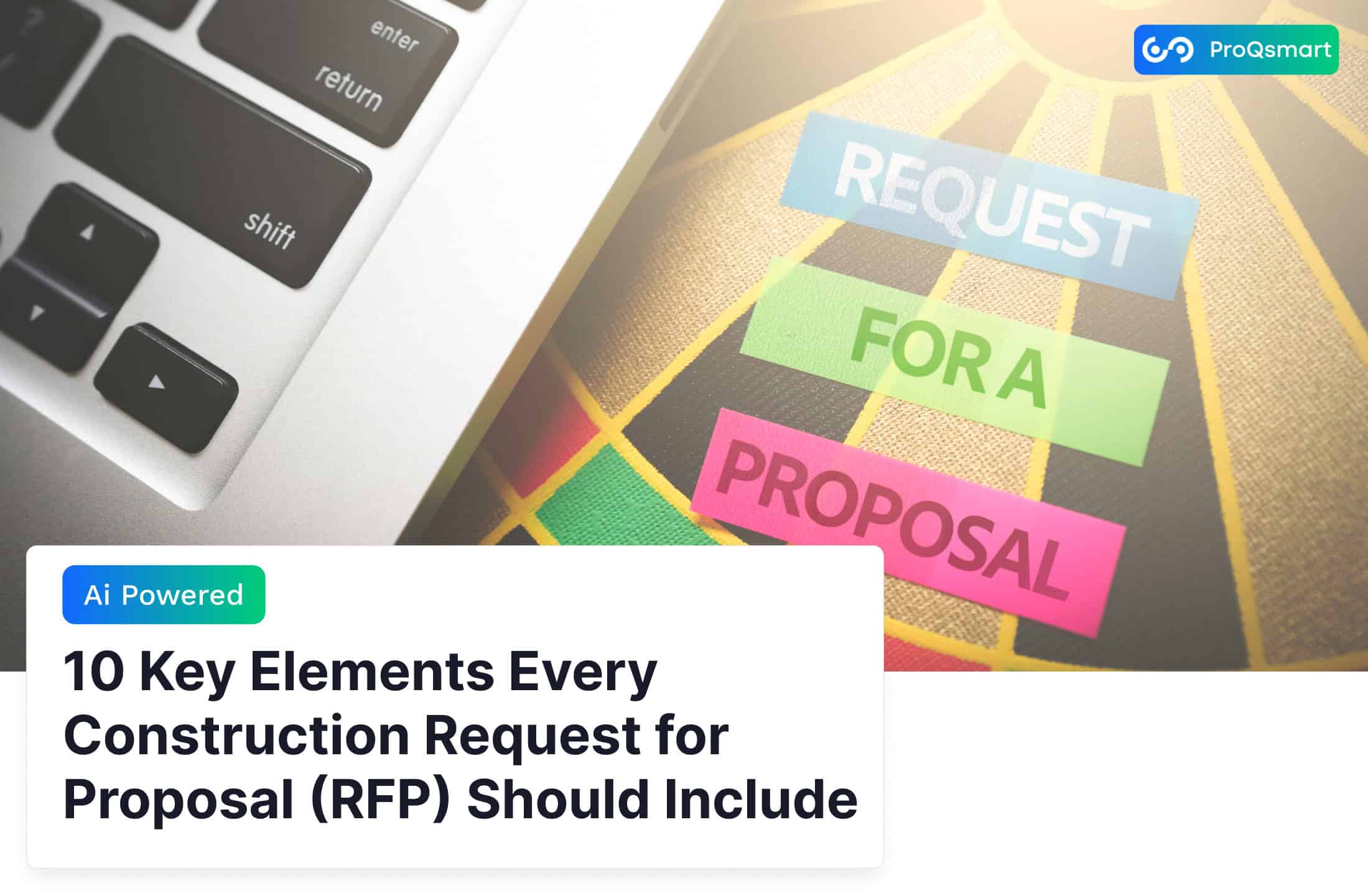Requests for Proposals (RFPs) are fundamental for connecting project owners to contractors. They help build the trust and understanding that successful collaborations require. Besides by establishing clear project requirements, RFPs make sure both parties are on the same page from the outset, resulting in a smooth and efficient execution.
Procurement teams are frequently stuck in the middle, faced with unclear requirements, drawn-out evaluation timelines, and a need for effective articulation.
This guide compiles these best practices to help improve the RFP process. By ensuring that it’s more flexible, efficient, and transparent, to hit their targets with speed and accuracy. It provides a helpful walkthrough of the 10 elements that are most important to include in any construction RFP.
Understanding the RFP Process

A Request for Proposal (RFP) is a formal document that solicits bids from interested vendors, and it is most commonly used in construction projects. This structured procurement process is crucial as it assists the procuring organization in establishing clear expectations and aligning all parties involved toward a common goal.
A well-crafted RFP not only leads to a more efficient procurement process but also strengthens the project outcome by encouraging both clarity and competition. It typically involves three core steps:
Discovery, Draft & Issue
Score & Shortlist, and
Select Winner & Contract.
This structured approach ensures that all aspects of the project are covered in an organized manner, helping to create a good RFP.
“Well-structured RFPs have a lot to recommend them. They lead to better project outcomes, better alignment with project goals, and a greater likelihood that the most qualified contractor is selected”.
Download Editable RFP Template for your industry!
Getting stakeholders involved from the beginning is key to making a successful RFP. This collaborative process is key to crafting detailed criteria, ensuring better decisions, and ultimately ensuring taxpayer investments generate strong outcomes. Open, honest as well as ongoing communication with your vendors is the best way to set expectations and cultivate long-term partnerships.
The challenge of processing RFPs through multi-page email chains filled with Excel and Word files can be overwhelming. However, leveraging an RFP tool can help solve these inefficiencies.
Taking the time to evaluate vendor responses against your specific requirements is essential for finding the best contractor for your needs. Additionally, an average RFP can include anywhere between 50 to 200 questions, and it takes time to thoroughly assess these responses to determine the best fit.
By employing a two-step process, starting with a Request for Information (RFI) and then moving to the Request for Proposal (RFP), construction companies can significantly be better informed about each vendor’s capabilities. Thus, this approach encourages competition, ensuring that agencies get the most value for their investments.
Key Elements of a Construction RFP

When developing a Construction Request for Proposal (RFP), the attention to details is critical for a successful project. Here’s a bullet list of ten essential elements for a comprehensive RFP:
Purpose of the RFP
Project Overview
Scope of Work (SOW)
Project Timeline
Budget Information
Evaluation Criteria
Submission Guidelines
Potential Challenges
Required Qualifications
Appendices and Additional Information
Each element plays a key role in ensuring the success of a project, by identifying explicit expectations and promoting good lines of communication.
Short, specific narratives for each section to define your project’s goals and objectives will guide bidders in tailoring their proposals to fit your needs. Thus, this kind of alignment is key to avoiding miscommunications down the line and laying the groundwork for a successful project.
1. Purpose of the RFP
The key purpose of the RFP is to direct potential vendors, solicit qualified bidders, and improve the quality of the proposal received. Additionally, a clearly articulated purpose is grounded in a greater business mission, providing strategic procurement benefits that go beyond the immediate purchase.
Besides, by making everything clear and obvious upfront, the RFP allows for an easy understanding and meeting of the minds, leading to smooth and productive negotiations.
2. Project Overview
The project aims to establish a clear vision and set of expected outcomes that align with the organization’s strategic objectives.
Define a clear vision for the project that aligns with organizational objectives, outlining the expected outcomes to guide all stakeholders.
Clearly articulate specific project goals to ensure focused efforts and measurable results throughout the project’s lifecycle.
Foster transparency to build trust among stakeholders while establishing a clearly defined scope of work. This clarity allows vendor proposals to accurately reflect the true intentions of the project, leading to relevant and realistic submissions.
A clearly defined scope of work sets the stage, allowing vendor proposals to reflect the true intentions of the project.
3. Scope of Work (SOW)
The Scope of Work (SOW) is essential for defining the specific tasks and deliverables necessary to achieve project objectives, particularly in the context of an effective RFP document. It outlines key components and as well as precise requirements, ensuring that all parties have a clear understanding of expectations. Moreover, a comprehensive SOW reduces risks by eliminating confusion and preventing miscommunication among stakeholders, ultimately enhancing project success through the bidding process. Besides, by serving as a roadmap for both the project team and vendors, a well-defined SOW guides them toward achieving desired results efficiently and effectively.
4. Project Timeline
The Project Timeline is a crucial element that includes key milestones and deadlines, providing a structured framework for project execution. It should feature realistic timelines that reflect the actual time required to complete tasks while allowing for flexibility to accommodate unforeseen challenges. Clear and unambiguous timelines are essential not only for the project team but also for potential bidders, as they help them plan effectively and allocate resources appropriately to ensure successful project delivery. Besides, by establishing a well-defined timeline, organizations can enhance coordination among all stakeholders and increase the likelihood of meeting project objectives on schedule through a good RFP process.
5. Budget Information
Providing a transparent budget breakdown is essential for project success, as it includes realistic estimates and clearly defined cost categories. This level of detail not only helps avoid conflicts during negotiations but also informs pricing information for vendors. Besides, by establishing well-defined budget parameters within the formal request, organizations can ensure that all parties have a mutual understanding of financial expectations, ultimately facilitating smoother collaboration and enhancing the likelihood of project success.
6. Evaluation Criteria
Specifying criteria for proposal assessment is crucial for effective vendor selection in the bidding process. By employing objective scoring methods and ensuring alignment with project needs, organizations can significantly streamline the evaluation process. Clear evaluation criteria not only help narrow down options more quickly but also enable fair and impartial vendor selection, ultimately leading to better project outcomes in the RFP process.
7. Submission Guidelines
Outlining submission requirements in the RFP document is essential for managing vendor expectations and ensuring smooth proposal submissions. This includes specifying consistent proposal formats and also acceptable delivery methods to streamline the bidding process. By providing clear guidelines, organizations can facilitate uniformity in submissions, making it easier to evaluate and compare proposals effectively, ultimately enhancing the overall procurement experience.
8. Potential Challenges
Identify challenges and propose solutions:
Risk mitigation strategies
Appendices and Additional Information
Addressing challenges upfront leads to smoother project execution.
9. Required Qualifications
Listing essential contractor qualifications is crucial for ensuring alignment with project complexity and specific requirements. Key qualifications should include relevant experience in similar projects, technical knowledge of construction methods, and proficiency in project management practices. Additionally, contractors should demonstrate strong communication skills, financial acumen for budgeting and cost control, and a solid understanding of safety regulations and building codes. Correspondingly clear requirements help filter out unqualified bidders, ensuring that only those capable of meeting the project’s demands are considered, ultimately contributing to the project’s success with a good RFP.
10. Appendices and Additional Information
Including supplementary documents, such as an RFP document, is essential for providing clarity in the proposal process. Relevant appendices should be organized logically to enhance understanding and accessibility. These additional materials offer further details that help vendors grasp complex requirements and contextualize the project scope. By supplying comprehensive supplementary documents, organizations can facilitate better-informed RFP responses, ultimately leading to more accurate and relevant submissions from potential vendors.
How to Avoid Common Pitfalls in Construction RFP

Being aware of common pitfalls can help you avoid costly mistakes.
Vague Descriptions and Unrealistic Expectations: Ambiguous language in RFPs can lead to unnecessary expenditures, similar to buying more than needed when only a gallon of milk was required. To avoid overspending, ensure your descriptions are specific and realistic.
Inadequate Review: Failing to thoroughly review your RFP can result in oversights that mislead bidders. With selection committees often sifting through extensive documentation, clarity is essential. A well-prepared RFP will stand out amidst the noise.
Ignoring Audience Diversity: Writing without considering the diverse expertise of your audience can lead to confusion. Tailor your content to be comprehensive yet accessible to various levels of understanding, ensuring that all stakeholders can engage with the material.
Underestimating Project Capability: Bidding on projects beyond your experience can damage public trust and credibility. If your firm has not managed a project of a certain scale, it is risky to pursue larger contracts. Be realistic about your capabilities.
Long-Winded Responses: Lengthy narratives can frustrate selection committees and demonstrate a lack of respect for their time. Stick to the allotted page limits and focus on succinctness to showcase your organization’s ability to communicate effectively.
How to Write an Effective RFP
We’ll break down the best practices for producing an effective RFP, including how to make your RFP clear, competitive, and procurement-ready.
Have a clear project scope and goals from the start. Write clear, specific RFP requirements to eliminate even the slightest possibility of misunderstanding. Including clear deadlines and evaluation criteria gives vendors even more direction to ensure they deliver what you’re looking for.
A bullet list of best practices goes a long way in helping vendors prepare complete responses. Add real-world advice such as writing in plain English, being clear on your terms and conditions, and describing the proposal submission process.
Stakeholder collaboration is key to the RFP creation process. By engaging the relevant departments early, you can go beyond the immediate ask to address all needs and concerns right from the start. This process encourages ownership and buy-in across the organization.
Regular reviews and updates of the RFP templates can lead to continuous improvement, adapting to changes in industry standards and business goals.
Utilizing technology and other tools is key to making the RFP writing process more efficient. ProQsmart provides the AI-driven solutions that help you efficiently manage RFP documents.
Its features, like e-tenders and automated workflows, make for a positive experience for suppliers. These tools help foster transparency and aid compliance with the Buy America provisions. The result is huge cost savings for the public and much faster procurement cycles.
AI-driven solutions like ProQsmart take the pain out of the RFP process by using content libraries and automated response systems. These innovations allow teams to get historical data and insights at their fingertips, improving the quality and speed of RFP development.
By embracing these technologies, procurement professionals can change the way they create and distribute RFPs, paving the way for a more informed, strategic decision-making process.
Conclusion
The RFP process plays a critical role in construction procurement. It lays the groundwork for successful project execution and strong supplier partnerships. By following the outlined best practices in this guide, you will create RFPs that attract competitive bids and establish clear expectations. Understanding common pitfalls and the nuances of your specific project needs will enhance your overall strategy. Equipped with these insights, you can improve bid evaluations and streamline decision-making.
Start enhancing your procurement efficiency by leveraging our RFP feature. ProQsmart ensures your workflow is more intuitive and your procurement process more effective. Book a demo today!






